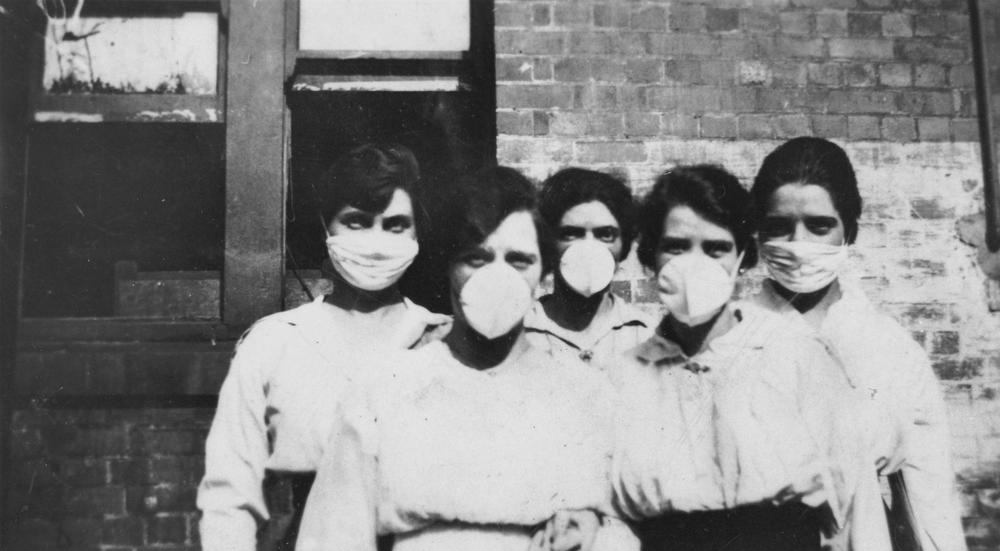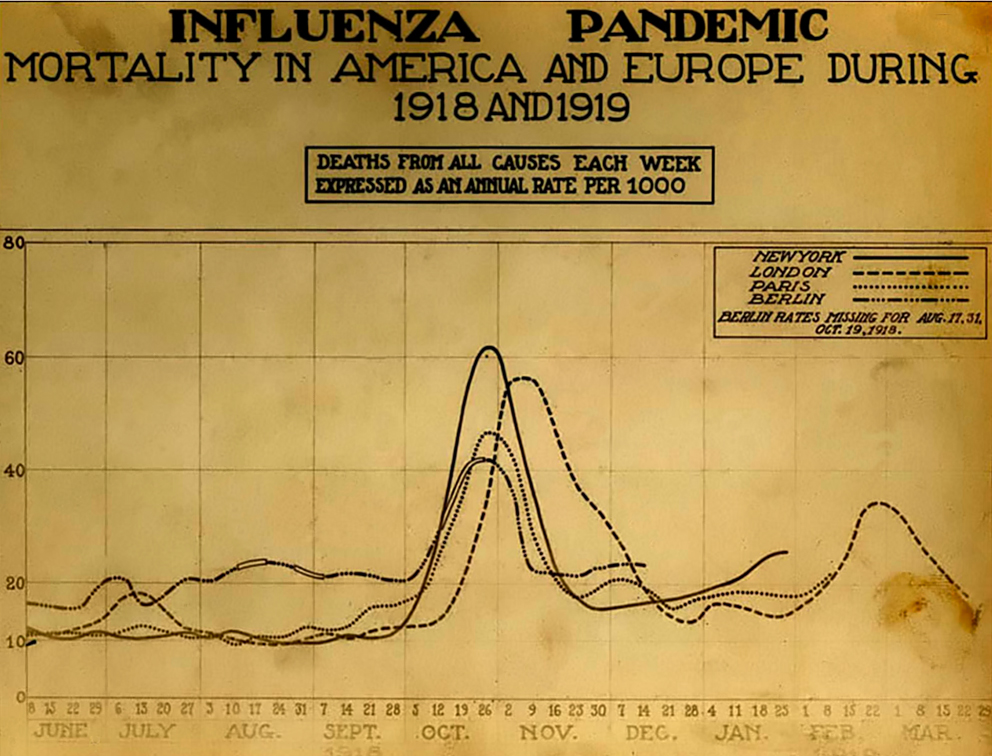Fashion and pandemics – living in a world that never ends
22 Apr, 2020
The original text was written in Japanese and published in FASHIONSNAP.COM on April 22, 2020. This post is translated from the original article.
 Photo © State Library of Queensland, Australia
Photo © State Library of Queensland, Australia
PANDEMIC AND FASHION
In the 17th century, the philosopher and mathematician Blaise Pascal (1623-1662) said,
“All of humanity’s problems stem from man’s inability to sit quietly in a room.”It is noted on “Pensées”, “J’ai découvert que tout le malheur des hommes vient d’une seule chose, qui est de ne savoir pas demeurer en repos dans une chambre.” Blaise Pascal “Pensées” (Mediaspaul)p.34
If we observe the current situation, we exactly see that the words resonate very strongly. The new coronaviruses that are now spreading around the world have been transmitted by human movement(or migration) and have completely changed our way of life. It is now having huge aftermath on the global and local economy.Infectious diseases are a scourge caused by the globalization of social movements In the fifteenth century, the Azteca and Inca empires were destroyed in Central and South America, which was hastened by the collapse of society in a pandemic caused by smallpox and other contagious diseases brought by Europe through the invader, the Spanish army. Jared Diamond’s “Guns, Germs, and Steel” (1997) is a must-read book, especially for people living in Asia..
In fact, the history of this pandemic is not unconnected with fashion. The Plague (Black Death) of the 14th century, which killed almost 20% of the world’s population, was said to be transmitted through the Silk Road, which linked China, the Middle East and Europe by land. Through the trade of silk, an essential part of luxury fashion from ancient times to the present, the virus spread drastically in the world.
A famous couturier Paul Poiret (1879-1944), famous for liberating women from the corset, also lost a family member to the Spanish flu that raged 100 years ago. The Spanish flu infects about 30% of the world’s population and is said to have killed between 40 million and 100 million people. It is commonly believed that what is known as the Spanish flu was actually spread during the First World War when U.S. soldiers travelled to Europe on an expedition. It is said that it took about three years for this pandemic to come to the end.The Spanish flu also raged in Japan, with 23 million people (40% of the population) infected in the country. 380,000 people, including members of the royal family, lost their lives. Considering that the Japanese population was around 55 million at the time, we could imagine how serious this must have been. At this time, the painters Egon Schiele and Gustav Klimt died in Europe. Max Weber also died. Data from the National Institute of Infectious Diseases at the time can be found here: Infectious Disease Surveillance Center (IDSC) of Japan
 Graph of the number of cases of Spanish flu. It is a familiar curve in the news these days of 2020.
Graph of the number of cases of Spanish flu. It is a familiar curve in the news these days of 2020.
Courtesy of the National Museum of Health and Medicine
Madeleine Vionnet (1876-1975)A good summary with mentions of Vionne and Poiret. Speaking of Poiret, the maison faded after he was hit by the First World War and the Spanish Flu.
“Madeleine Vionnet, master in manipulating fabric”
“Madeleine Vionnet (1876-1975)” Business of Fashion, who was active in Paris at the same time as Poiret, would not have been immune to this dire situation. Her maison was located along Rue de Rivoli in front of Tuileries Garden, on the block where the bookstore, Librairie Galignani now stands. Many fashion insiders may have walked this area during fashion week.
In 1912, at the age of 36, she became independent, but two years later, in 1914, World War I forced her to close her shop, then Paris was caught up in the Spanish flu pandemic during the war. The maison reopened in 1919, five years after it closed. However, 20 years later, her maison was again closed for World War II and never reopened even after the war was over. For her, it must have been a so-called “WTF” situation that went beyond “saying just unlucky”.
I’ve never thought about pandemic and fashion together, but looking back at history in this way, there is something about the designer and fashion business that cannot be revealed simply by looking at an illustrated book or a museum exhibition.
 The Age of Paul Poiret. A view of Paris before the pandemic, in the Luxembourg Gardens in 1917.
The Age of Paul Poiret. A view of Paris before the pandemic, in the Luxembourg Gardens in 1917.
“Melles Madeleine Godinier and Miguette Mesnard posent dans lejardin du Luxembourg à Paris. 11 MAR 1917” Photo © Wikicommons
THE FASHION MARKET SUPPORTED BY CHINA AND THE RISE OF EMERGING COUNTRIES
The 2021 Spring-Summer Men’s fashion week, which is set to start in June 2020, has been cancelled and
the supply chain and retail and wholesale structure are currently undergoing a radical overhaul, with no promise of its reopening in September, and even if it did, it’s unclear how many customers it would attract. Companies are still trying, but it is difficult to recover from the damage in a short period of time. The disappearance of consumption by tourists, as countries blockade cities and cross-border movement is no longer free, has also been a major blow. Especially since 2010, luxury and high-end fashion has been supported by the strong purchasing power of Chinese consumers.
Prior to the new coronavirus, there was an outbreak of SARS in China in 2002, but we did not experience an economic crisis like the current one. One possible reason for this is that the Chinese were not able to travel abroad freely at that time.
The ban on Chinese people travelling abroad for tourism to Japan was lifted in 2000, and even then, free travel was limited to people in Beijing, Shanghai, and Guangdong Province. After that, the number of areas that could be travelled gradually increased. The ban was lifted by the government in 2004 for European countries and in 2008 for the United StatesJapan National Tourism Organization, “Handbook for Attracting Travelers to Japan” (2019).
The number of people leaving the country has grown rapidly since free travel became available, and in 2017, 130 million people, which almost correspond to 10% of the population of China, travelled abroad. It’s hard to tell the scale if we just look at the figures, but if we consider this number to be the same scale as the entire Japanese population travelling abroad every year, we will see how astounding this is. As this fact is well known, this growth of tourism is proportional to China’s economic growth. According to World Bank data, China’s GDP in 2002 was 1.47 trillion U.S. dollars, which was about one-third the size of Japan’s economy, but in 2018 it reached 13.6 trillion U.S. dollars, growing more than nine times in about 16 years to become the world’s second-largest economy Data from 1960 to 2018 are available in the data bank provided by the World Bank. The U.S. has nearly doubled in 16 years, from $10.93 trillion in 2002 to $20.5 trillion in 2018. This means that, on average, the U.S. has been growing at about 4% on an annual basis. If you look at Japan, it was $4.88 trillion in 2002 and $4.97 trillion in 2018, with a poor growth rate of 1.8% over 16 years. It is worth noting that in 2002, Japan’s economy was about half the size of the U.S. economy, but now it is a quarter of the size of the U.S. economy.
When I visited London and Paris for Men’s Fashion Week in January 2020, I found many displays of simplified Chinese characters such as “新年快乐” and “Happy Lunar New Year” in the cities. The global brands enthusiastically display Chinese New Year ornaments and products featuring the Chinese zodiac. This sight would have been unthinkable ten years ago. This real scene illustrates how the fashion market was supported by the overwhelming purchasing power of Chinese tourists.
Needless to mention, and many fashion insiders were probably hesitated to talk in public, however, the direction of fashion trends, product design and visual marketing since 2010 has been clearly lured by money in the Far East, China and the Middle East. From 2002 to 2020, LVMH, the biggest fashion conglomerate, has seen its stock price grow sevenfold and sales quadrupled, from $15 billion to $60 billion. The growth rate in Asia is, of course, noteworthy, especially in the period from 2010 to 2020. LVMH’s annual report is a very useful resource for catching the geographical market trend of high-end fashion. Here’s a report on 2002: LVMH Annual Report
CENTRALIZED GLOBAL NETWORK
There are those who are concerned that this pandemic will cause social fragmentation “Yuval Noah Harari: the world after coronavirus”Financial Times, March 20, 2020, but I believe this will be unfounded in the end, considering given economic rationality. The fashion and global economic system, which has been spreading around the world for many years, will probably be updated rather than disrupted by this incident. I think our greatest fear is that the gap between “those who have” and “those who don’t have cross-border connections” will widen more.
A place where people gather, even across countries and products that can not be easily touched without travelling effort can attract new solidarity across borders by chance. The trust and experience patiently built up with communication that has come about over time are not easy for a newcomer to building with online communications and remote deal. In fact, we were aware that in the last couple of years, brands and media that had been operating exclusively online were creating real places and real products(objects), such as real retail stores and paper publications. I think this is because society has entered into a cycle of rediscovering the value of connections created through real places and objects. The Internet has made information accessible from all over the place, allowing us to look up everything from what’s going on the runway, to new product developments, to people’s relationships in real-time. In recent years, the value of things has come to be measured in terms of the social influence of the people and organizations involved in them.
What we have come to know through the development of the Internet is the fact that online connections amplify, not counteract, the value of physical connections between people and things. The premise of value is that there must be people and things there first.
If it becomes difficult for people to move and travel as it is now, people will have no choice but to work from the existing human networks they have built. If many companies and people are going to expand on the trust that they have already built up, it is likely that the power will be concentrated on global companies that have already accumulated social influence and trust. Therefore, the possible future scenario is that globalization will proceed in a centralized manner.
BARGAIN SALE OPPORTUNITY FOR THOSE WHO ALREADY HAVE
In terms of scale, it is the global companies around the world that have suffered the most damage by COVID-19, but it will also be the global companies that have built up international networks that will recover quickly. In fact, Taiwan, China, Hong Kong, and South Korea, which have already survived the first wave of the pandemic, have begun to move forward with new plans for the next season. Moreover, the first to take advantage of the signs of recovery are the global companies that have stores and relationships in these regions. Companies that are able to pick up demand quickly, not only online, but also in real locations around the world, are slowly getting back on track to correcting themselves over time. This article of WWD.COM is interesting as an example of a release of energy for consumption after the pandemic, although there is some question as to whether the pandemic is really controlled.
”Hermès Hauled in $2.7 Million in One China Store on Saturday”WWD.COM, April 13, 2020
In the recent fashion world, similar to the relationship between Silicon Valley startups and GAFA, fashion brands and makers have tended to sell their businesses to investment firms or large corporations to exit rather than expand independently.
This trend is dominant especially in the high-end fashion field since 2010, where international capitals such as LVMH and KERING have been creating trends by mergers and acquisitions. These conglomerate companies leverage the synergy between the acquired brands and their portfolio companies to create macroscopic trends, doing “macroscopic fashion design” so to speakComme des Garçons exhibition at the MET Museum, “Rei Kawakubo/Comme des Garçons: Art of the In-Between” made a chapter break in the movement of contemporary fashion, then moved to the next chapter. This point was discussed in “The End of the Heisei and the Beginning of the Reiwa : The Birth of Contemporary Fashion and Macroscopic Fashion Design” in April 2019. The original text was written in Japanese for Fashionsnap.com.
It is a characteristic of capitalism that a powerful capital becomes even more powerful. Ironically, this pandemic will cause global capitalism to grow at a more accelerated rate, rather than slow down, and that too in a more centralized form.In fact, Apple seems to be increasing its acquisition deals in this period at a faster pace than last year. There has also been a lot of news recently about Chinese capital targeting companies whose values have plummeted.
“Apple’s 2020 Buying Spree: Tech Giant Reportedly Acquiring NextVR For About $100M” Techcruch, April 6, 2020.
“China Is Bargain Hunting—and Western Security Is at Risk” Foreign Policy, April 15, 2020
For capitalists with cash to spend, this situation is an unprecedented “buying opportunity” now that the economic turmoil caused by the pandemic has decimated the asset values of most companies and brands. The companies that lost a lot of cash in this case, but still have good brand value, will likely be merged and absorbed by global capital one after another in the next year or two. Accordingly, the business form, such as fashion week schedule, its methods, and season cycles will likely be determined by the movement of players who have taken advantage of this opportunity to accumulate power.
ACTING IN A LONG RANGE TIME SPAN
There are probably many people who have had indigestion about the endlessly accelerating fashion system that focuses on “this and now moment”. Many might hope for a reset, but cruelly, global capitalism is not equipped with the brakes that would allow it to “gentle slow descend”. As the descent is driven by the energy of human fear and anxiety, a mechanism that can only be a “swoop with the name of slowing down”.
It cannot easily be compared to the days of Madeleine Vionnet, who was forced to take a five-year leave of absence due to a huge calamity nearly 100 years ago, but history has proven that society does not reset itself even by pandemic or war. This is because society, despite being destroyed by pandemics and war, keeps moving remained broken rather than reset and updated. What would she say if we showed her the current state of fashion? They might just say, “Just survive” maybe.
As an aside, while the world is suffering from a pandemic, there is a news report that the mathematical problem called “ABC conjecture”, which has remained unsolved for over 30 years, has been solved by a brand new theory invented by a Japanese mathematician named Shinichi Mochizuki. It is a novel theory that has been validated for more than eight years since the paper was published, and it is said that the theory will still take decades to be understood by the majority of mathematicians.“The Mochizuki’s Theory of Mathematics, the first of its kind in human history, is a once-in-a-century achievement. Interview of Fumiharu Kato.” Sankei News, Apr 13, 2020.
The economy is driven by people’s desires and dreams. I work in this world because I believe that fashion is the area in which it excels the most – acting on people’s desires and dreams and creating the dynamics of human society. I think there is an opportunity to work in “this moment”, focusing on survival first, but looking ahead from a few months to a few years to a decade in the future. Man’s time is finite, but if we survive, we can move. And we ourselves are a part of society.
We must survive “this moment” first. However, I think the opportunity has arisen to work with a view to decade scale range rather than a few months or a few years. Our time is finite, but as long as we survive, we can move and act. We need to remember the fact that society is not belong to outside of ourselves, we are a part of the society itself.